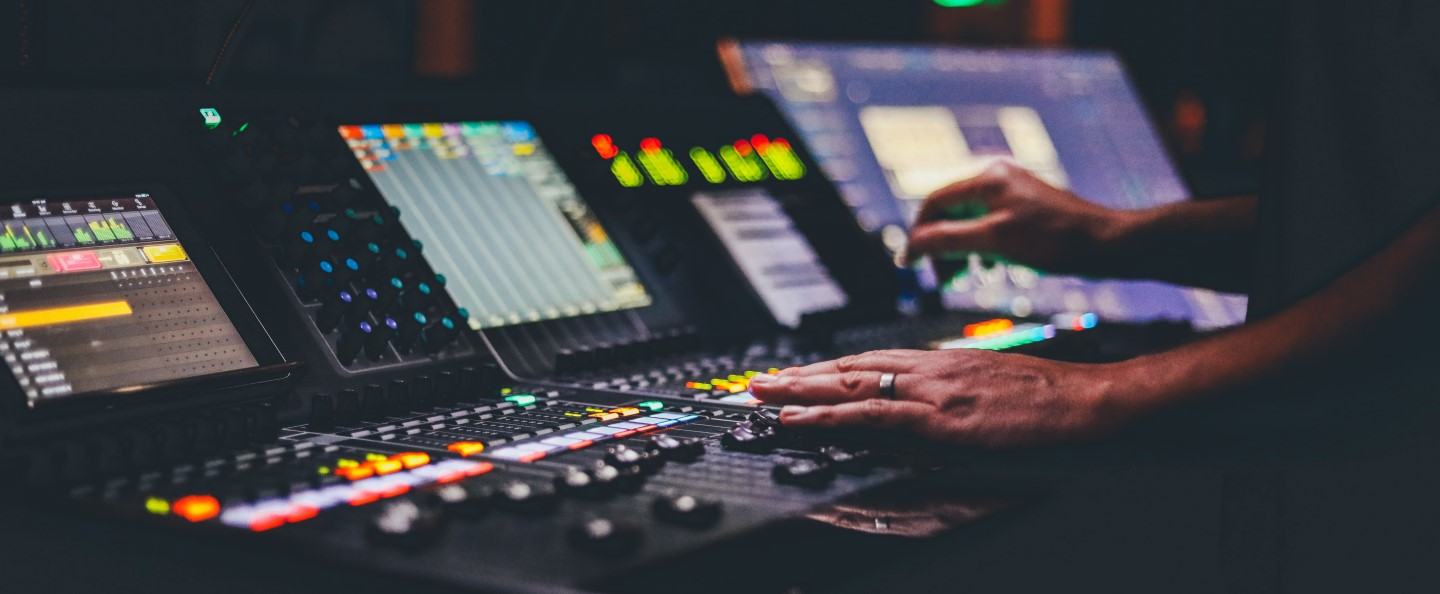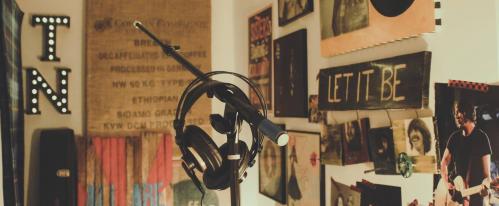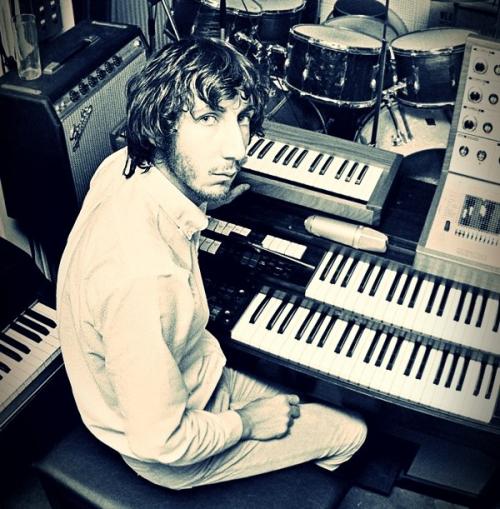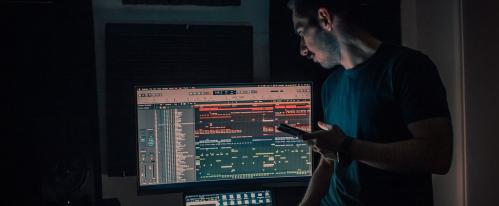What is Dolby Atmos? We take a look at how to use Atmos and Apple Music Spatial Audio as well as exploring some alternatives to Atmos
Ever since Apple announced it would be offering Spatial Audio with Dolby Atmos on its streaming service, there has been much written about what the future might hold for producers, audiophiles, and everyday music fans.
But what is Dolby Atmos? In this blog we’ll take a look at how to get started with streaming music that is mixed for Atmos, how to utilise Spatial Audio, and some ways you can experience immersive audio.

What is Dolby Atmos?
Most people are familiar with what we call ‘surround sound’. This is when speakers are placed in such a way around a subject that sound is delivered from different points at the front, back, and sides for a more vivid listening experience.
Surround sound tends to be configured in 5.1 or 7.1 setups. In this scenario, the first number refers to the amount of speakers around a subject, and the last number refers to the low-frequency channel (a subwoofer).
In an immersive mixing studio, speakers are positioned in three-dimensions, and so an extra number is added. Some common configurations include 7.1.4, 9.1.4, and 9.1.6, whereby:
- The first number refers to the speakers around the subject
- The second number refers to the subwoofer(s)
- The last number refers to speakers above the subject
This image, courtesy of Dolby, shows a 7.1.4 room setup:

The presence of an extra-dimension when mixing music opens up a world of possibilities that are only just starting to be explored, and immersive audio such as Dolby Atmos for music looks like it’s here to stay.
What Does Spatial Audio Mean?
The first thing to know about Spatial Audio is that it does not require a Dolby Atmos mix to work - traditional surround sound mixing will suffice. With this being said, Atmos mixes will deliver an optimum listening experience in Spatial Audio.
In the past we have been introduced to 3D headphone audio with Dolby’s own ‘Atmos for Headphones’ and Sony’s ‘360 Reality Audio’ format. Now though, Apple has offered its own take on the technology.
Apple’s Spatial Audio utilises gyroscopes and sensors within headphones to recreate a 3D environment that remains static even as you move. In simple terms, the sounds you are hearing are no longer fixed to your head, but to your device.
This means that you are able to turn towards different sounds and hear them in front of you - a completely unique and vibrant listening environment.
For now, this movement-based technology is available only for movies - Atmos-mixed music, however, can still be streamed via Apple Music.

Streaming Immersive Music
As well as becoming recently available via Apple Music, immersive audio streaming is accessible via Amazon HD and Tidal. Sony’s 360 Reality Audio is also available to stream via Deezer HiFi, too.
Listeners with access to a multichannel media room or Dolby Atmos soundbar will be particularly excited by these developments, but users can also listen via headphones for an introduction to immersive audio.
Dolby Atmos for Headphones, alongside Sony 360 RA, uses audio object metadata to position audio within a full 360-degree space. This allows engineers to place different aspects of the music around the listener, creating the feeling that you’re right in the middle of a live show or recording session.
Not all headphones are compatible with immersive audio however, so make sure you’re fully-compatible before you try to get it set up.

Working with Immersive Audio
Mixing audio for immersive formats is a highly-skilled task that requires an abundance of kit and technical knowledge. When working with Atmos audio, you must have access to Pro Tools Ultimate, Dolby Atmos Renderer, and an interface with enough independent outputs for the monitors and headphones - as well as making sure it all meets spec!
Ollie Dow is an immersive audio engineer who has worked extensively in Sony's immersive audio format, 360 Reality Audio, as well as working on Atmos projects.
He has worked on mixes for over 1000 projects in 360 Reality Audio, including releases by Joy Crookes, Quinn XCII, Tom Grennan, and Upsahl.
Here, he tells us a little more about what needs to be considered when working with these formats..
Tell us about your immersive audio set-up..
My current immersive audio setup is all ADAM Audio;
- 3x S2V for Left, Centre and Right
- 4x A7X for Side surrounds and Rear surrounds
- 6x A5X for height channels
- 2x Sub10 for LFE and bass management.
This is a 7.2.6 configuration. The minimum spec for Dolby Atmos is 7.1.4, the preferred being 9.1.6. So my setup sits in between the two, mainly due to the size of my room.
Check out how New Wave Entertainment uses ADAM Audio in their Atmos mixing facilities.
What sort of things must be taken into consideration when creating a Dolby Atmos room?
There are 3 main things to think about when creating a Dolby Atmos room - the room size, the speaker layout, and the SPL (Sound Pressure Level) output of each monitor. If you have any 2 out of the 3 you're in pretty good shape. Ideally you want all 3, but budget and room size can often be the deciding factors. Dolby has an Excel calculation sheet called a DARDT to calculate if your monitor setup and room layout is within specification.
What exactly is required from each monitor?
Dolby requires between 79dB and 85dB of output (depending on your standard) at the listening position, with an additional 20dB of headroom per speaker.
For example, the ADAM S2V states a 120dB peak SPL at 1m - so if your listening position is 2 metres away from the monitor, peak SPL will drop to approx 114dB, which would be well within the required 105dB (85dB + 20dB headroom) for a gold-standard Atmos mixing room.
Even though you wouldn't be mixing at these volumes, the system needs to be able to play back an Atmos mix mixed at -18LKFS with a max peak of -1dBTP without distorting any of the monitors.
One of the hardest parts is the preparation of the stems for Atmos mixing. Most stereo mixing engineers use a top down method of mixing, where the audio is mixed into a master processing chain and then this stereo mix is printed and sent to mastering, where additional processing is applied.
Re-creating this ‘glue’ that comes with bus processing is tricky. The work-around a lot of Atmos engineers use is to bus all of the stems into an audio track set to input monitor (which becomes the master fader in this application), then apply compression, EQ etc until it matches the master.
The next step is to bypass all processing from the audio track and print the mix. Afterwards, copy the processing used on the master fader to the audio tracks, EQ’s, compressors, etc in the same order as the master fader - but this time you’ll use the stereo track you printed as a key input for the compressors.
This will allow the tracks to then be committed to make new stems that will sound very close to the master. This may sound complicated but it does work quite effectively.

Watch out!
There is a risk of pulling the mix apart when panning and automating moves in Atmos - ‘holes’ in the audio start to develop and the mix may lose impact.
When picking monitors for this, the ideal is to have the same monitor for every position, but budget and practicality are often the deciding feature. I'd love to have a room full of S3H monitors but I didn’t have that sort of cash to blow! I went with ADAM because I’ve worked on them extensively in the past and already had a pair of S2Vs to start with for stereo mixing.
Things start to get tricky when looking at the overheads and surrounds and monitors with lower outputs, especially when on a budget. The A5X is a great choice for that, because you can mount them with two M6 bolts to any mounting bracket and they have a very reasonable frequency response especially when coupled with a bass management system.

Is it possible for people to get a taste of immersive audio mixing at home?
A large part of Atmos music mixing is binaural - the ADM (Audio Definition Model) files are accompanied by a binaural impulse response file that holds all of the binaural information. Because of this, when mixing in Atmos the engineer should regularly check the binaural mix.
In terms of an affordable immersive audio setup, I would suggest using headphones and the binaural output. There is a lot to learn in the Dolby Atmos Renderer, but Dolby is currently offering a 3 month trial so before starting to sink a lot of money into this you can see if it’s your thing!
You can keep up with Ollie on Instagram at @ollie_dow for some further insight into working with immersive audio.
Is Immersive Audio the Future?
Immersive audio is slowly but surely becoming more commonplace - that much is a fact. For a long time it has been central to the experience of moviegoers, and other forms of immersive media such as VR have piqued the public’s interest over the past several years.
Composers working in the film, television, and gaming industries are therefore spearheading the immersive audio revolution, using their increased freedom in order to create expressive art that can only be experienced fully in an immersive environment. But musicians now have the opportunity to bring listeners into their soundworld like never before, and far from being a gimmick, it’s likely we’ll see more and more releases that utilise immersive experiences.
Already we are seeing places like nightclubs adopt Atmos-standard speaker systems, with Dolby even creating applications that allow for full manipulation of a 3D soundfield in real-time. The emotional impact of audio in this 3rd dimension has to be felt to be believed, but as more and more artists are able to utilise the technology and tools of the trade, it won’t be long until more people can experience it for themselves.
It’s difficult to imagine music beyond the stereo field that has been commonplace for over 50 years - but now it seems that the time for true immersion may be closer than we thought.
Got more questions about immersive audio? Interested in setting up an Atmos studio or listening space? Call us on 0151 448 2089 or check out your local store to speak to one of our Experts about your needs.




